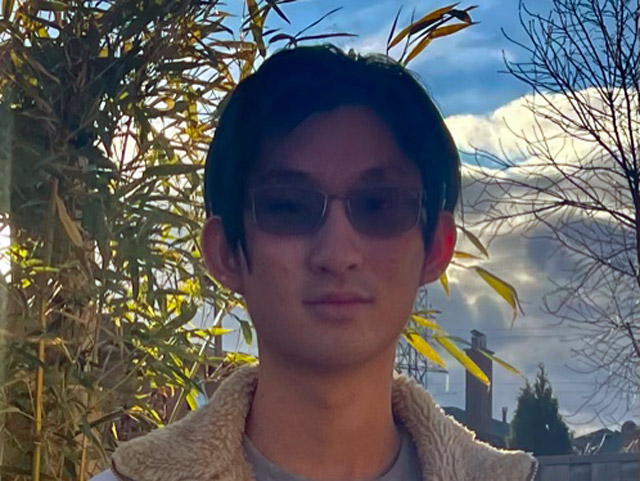2021 Undergraduate Student Research Awards Recipients
Each year, the National Sciences and Engineering Research Council of Canada (NSERC) awards undergraduate students with the Undergraduate Student Research Awards (USRAs). Valued at $6,000, the USRAs are intended to nurture scientific interest so that students can fully develop their potential for a research career in natural science and engineering. They are also meant to encourage students to pursue graduate studies in these fields.
Fourteen students from Ryerson University’s Faculty of Science received and accepted USRAs in 2021. Please note that the research projects of two students, Valeria Morozova (supervised by Stefania Impellizzeri) and Raduanul Islam (supervised by Konstantinos Georgiou) have not been included in this article.

Title: Smart Fire Alarm System Case Study: Model-Driven Requirements Elicitation Using UCM4IoT
Supervisor: Sadaf Mustafiz
Smart Fire Alarm Systems are safer than traditional systems as they automatically alert the fire department and user when a fire is detected. This increases response time and reduces preventable deaths. The Smart Fire Alarm System designed by Abedin is a case study to showcase how the UCM4Iot (Use Case Modelling for Internet of Things) environment, developed by Dr. Sadaf Mustafiz and her team, facilitates requirements elicitation, analysis, and specification of IoT systems. Abedin also designed the system using existing requirements engineering approaches and subsequently evaluated the benefits of UCM4IoT by performing a comparative analysis of the results.

Title: Development of next generation solar cells
Supervisor: Bryan Koivisto
Grandy supported novel research at Dr. Bryan Koivisto’s solar energy lab. Her work focused on the synthesis of photosensitized dyes and fabrication of dye sensitized solar cells. Dye sensitized solar cells, like all solar cells, are used to convert sunlight into electricity. However, our solar cells offer many advantages. For example, they are optically transparent and are efficient under low light conditions. Current research has focused on the fabrication of thin, transparent, and photoactive films that will allow existing surfaces to harness energy from the sun. From windows on skyscrapers to screens on cell phones, ultimately all surfaces can harness sunlight using this next generation photovoltaic technology.

Title: Identification and Prioritization of Persistent, Mobile, and Toxic Plastic Additives Registered for Use in Canada
Supervisor: Roxana Suehring
Currently, there is a lack of regulations in Canada against plastic additives that are persistent, mobile in water, and toxic (PMTs). These unregulated PMT plastic additives are a threat to the quality of drinking water sources, and wastewater treatment plants (WWTPs) are suspected to be important transport pathways for their entry to freshwater environments. The goal of Grewal’s project, supervised by Dr. Roxana Suehring, was to identify and prioritize PMT plastic additives registered for use in Canada according to their predicted removal efficiencies from WWTPs. The results of this project will inform chemical contaminant policy and provide stakeholders with a comprehensive library of priority emerging PMT plastic additives that are predicted to move through WWTPs.

Title: Universality in Prediction Markets
Supervisor: Sean Cornelius
In a Prediction market (PM), participants buy and sell contracts tied to the outcome of real-world events in a winner-takes-all game. At any given time, the price of these contracts offers a crowd-sourced assessment of the event’s probability, responding to new information in real time. Lanctot analyzed a set of approximately 2800 contracts from PredictIt, one of the most popular online PMs covering real-world events. As a lead researcher on this project, he found strikingly regular statistical laws governing: the distribution of price fluctuations, the frequency of fractional price over time, and the frequency of volume of trades over time. He also found that price time series cluster naturally into a small number of archetypal patterns. Results suggest that the huge number of degrees of freedom in this large, human driven system belie a much lower-dimensional space of variables that explain market dynamics.

Title: Structural and Functional Characterization of a Putative Bacterial Tyrosine Phosphatase
Supervisor: Dustin Little
Most species of bacteria are harmless to humans, however under the right conditions certain strains of bacteria can become pathogenic and cause disease. Escherichia coli is one of these bacterial species that has evolved strains that are uniquely armed with the ability to cause many of the food-borne illnesses and food-related outbreaks we often see on the news. One of the ways E. coli can do this is with complex multi-protein secretion systems that rely on intricate interactions that allow the bacteria to attach to our gastrointestinal tract, intoxicated our cells, and cause disease.
With this project, the research team led by Dr. Dustin Little focused on proteins that they believed played an important part in regulating the function of a key protein secretion machine that is required for E. coli infection. As part of her role, Ms. Sindi Mukaj performed numerous experiments that investigated how a modification known as protein phosphorylation affected the structure and function of key regulatory proteins that controlled this protein secretion system. Through this work, they hope to better understand how protein secretion systems are regulated, and leverage this knowledge to develop new therapies to better treat E. coli infections in the future.

Title: Exploring Phenotypic Heterogeneity in S. cerevisiae
Supervisor: Mojca Mattiazzi Usaj
Under the supervision of Dr. Mattiazzi Usaj, Nguyen has been working on exploring the concept of phenotypic heterogeneity - a phenomenon where cells that are grown in the same environment and have the same genotype do not always look or behave the same. Using S. cerevisiae (budding yeast) as a model organism, Nguyen spent the summer creating various strains of yeast that will be used for imaging as part of Dr. Mattiazzi Usaj’s project. In imaging these strains, they hope to provide further insight into the sources of phenotypic heterogeneity, which may have important implications in both medical and industrial fields in the future. For example, understanding phenotypic heterogeneity and its consequences, may translate to a better overall understanding of the progression of genetic disorders, which ultimately allows for the design of more effective treatment strategies.

Title: Novel ATR inhibitors in combination with gemcitabine to increase DNA mis-segregation and death in a yeast model of tumour cells
Supervisor: Sarah Sabatinos
This summer, Pellegrino, alongside her colleagues, tested new chemotherapy drugs on yeast cells to improve current cancer treatment with gemcitabine. Cancer cells grow uncontrollably due to compromised regulation in their cell cycle. These tumour cells will thus rely on an alternative way to survive with regulated growth and will resultantly enter the ATR pathway. That’s why they tested ATR inhibitors as a chemotherapy agent to target these specific cells that enter this pathway and promote their death. Adding these ATR inhibitors to gemcitabine can increase its effectiveness as a chemotherapy agent.
Fission yeast cells were used as a model for human tumour cells due to its fast replication rate. The team, led by Dr. Sarah Sabatinos, tested if these cells were affected by the drugs that analyzed their nucleus, containing DNA, under the microscope. One drug showed a significant difference on yeast cell appearance when it was added to gemcitabine, and as such, more research should be conducted to analyze this drug as a new chemotherapy agent. Pellegrino’s role in the project was to analyze the cells under the microscope and calculate the cell lengths to compare with and without treatment to see if there was a significant effect.

Title: Investigating the Functionality of PmrD in Shigella flexneri Upon Exposure to Different Polymyxin B Concentrations
Supervisor: Joseph McPhee
Shigella flexneri are a type of bacteria spread through contaminated water, food, or contact with feces. The McPhee lab is especially interested in studying this bacteria to understand how it regulated resistance to antibiotics similar to those produced by the host. Shigella have evolved from Escherichia coli both by acquiring new genetic material and by inactivating existing genetic material. In this project, the team studied a gene, pmrD, with a mutation that is predicted to inactivate the gene. In this project, Pham’s role was to investigate whether the inactivated gene was able to restore normal function through a process termed phase variation.
There was mixed evidence suggesting that when this bacteria was exposed to an antibiotic, some of them were able to revert the mutated gene to resist getting killed by the antibiotic. Future experiments should aim to confirm this observation and to further study the populations of bacteria that had these specific mutants in order to understand how these bacteria adapt to in host environments

Title: The Application of Metal-Enhanced Fluorescence for the Imaging of Lysosomal Dynamics
Supervisor: Costin Antonescu
In order to study the cell, researchers use light-emitting molecules called fluorophores to track and label structures within cells. However, there are still challenges in visualizing cellular structures with this technique. Santhireswaran’s project, supervised by Drs. Antonescu, Impellizzeri, and Botelho, focuses on using silver nanoparticles to help improve the accuracy and brightness of these light-emitting fluorophores. Moreover, exposing cells to high intensity light in this process causes harmful effects, which was found to be resolved when using lower light exposures alongside silver nanoparticles that help produce high quality images at even lower levels of light. Overall, the use of these metal nanoparticles allowing us to better visualize and track processes and structures within cells.

Title: Location of Focal Spot
Supervisor: Jesse Tanguay
Under the supervision of Dr. Jesse Tanguay, Sims conducted an experiment to determine the approximate location of the focal spot within the X-ray tube. Using the trial and error method with different source-to-detector distances, tube voltages, and tube currents it was possible to determine the additional distance required to reach the focal spot. By finding the location of this focal spot we can get a better understanding of how far the source of the x-ray is from the person or item being x-rayed.

Title: Assessing Airway Structural Changes using CT Imaging following CFTR Modulator Therapy in the Adult Cystic Fibrosis Population
Supervisor: Miranda Kirby
Last summer, Singh worked on a project that evaluated the structural changes that occur in the airways of cystic fibrosis (CF) patents following treatment, supervised by Dr. Miranda Kirby. CF is an autosomal fatal genetic disease caused by defects in the cystic fibrosis transmembrane conductance regulator (CFTR) protein, and these defects result in progressive airway disease and eventually respiratory failure. The goal of his research was to use computed tomography (CT) imaging to determine how the airway tree changes before and 1-year after CFTR modulator therapy in CF patients. This was done by developing novel image analysis approaches to extract the airway tree measurements. The results of this research provide a way to measure the structural changes in the airways, and ultimately to help better understand the structural changes that occur following modulator therapy in CF.

Title: Investigating the role of receptors in the process of phagocytosis
Supervisor: Robert Botelho
Within our immune system we have specialized cells called macrophages which play an important role in the immune system to help fight infections and maintain our health. They do this by recognizing and uptaking things like pathogens as well as cell debris/waste. As a result of all the functions they provide, they are a critical asset to the immune system to keep us healthy as well as combat infections.
Macrophages recognize and essentially eat foreign invaders through a process called phagocytosis. For macrophages to do their job, they must recognize and uptake such pathogens. Macrophages have specialized proteins on their surface called receptors that allow them to recognize, bind, and eat such foreign invaders. Supervised by Dr. Roberto Botelho, Soffiaturo examined a specific receptor called cluster of differentiation 36 (CD36). She looked at how CD36 plays a role in the uptake of the bacteria Escherichia coli (E. coli) by macrophages. To understand the significance of this receptor, they used techniques to create cells that did not have functional CD36. They fed those cells E. coli to see if the macrophages were still able to eat and degrade such bacteria. This allowed them to understand if CD36 is essential for the process of phagocytosis.